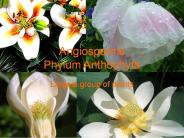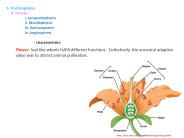Eudicots PowerPoint PPT Presentations
All Time
Recommended
... Daisy Flowers Asteraceae Fruits Sarraceniaceae Pitchers Sarracenia flowers Droseraceae Dionaea Cactaceae Basal Placentation Evolution Ericaceae Ericaceae ...
| PowerPoint PPT presentation | free to download
Monocots and Eudicots (Dicots) Comparison of Plants and Seeds Review: Classification of Plants Kingdom - Subkingdom - Division Class Order PLANTS Bryophytes (non ...
| PowerPoint PPT presentation | free to download
Diversity And Classification of Flowering Plants: Eudicots Michael G' Simpson
| PowerPoint PPT presentation | free to view
4. Eudicots- the largest group Laurales Magnoliales 2. Magnoliids Piperales Canellales 3. Monocots 1. Basal Angiosperms Monocot: 1 cotyledon Dicot: 2 cotyledons ...
| PowerPoint PPT presentation | free to download
4. Eudicots- the largest group Laurales Magnoliales 2. Magnoliids Piperales Canellales 3. Monocots 1. Basal Angiosperms Monocot: 1 cotyledon Dicot: 2 cotyledons ...
| PowerPoint PPT presentation | free to download
Diversity And Classification of Flowering Plants: Eudicots: Rosids Michael G' Simpson
| PowerPoint PPT presentation | free to view
Absolute Angiosperms. Magnoliophyta. Primitive Angiosperm Lineages. Amborella trichopoda ... Monocots vs. Eudicots. Eu- Monocots vs. Eudicots. Basal Eudicots ...
| PowerPoint PPT presentation | free to download
... Tracheophyta; Spermatophyta; Magnoliophyta; eudicotyledons; core eudicots; rosids; eurosids I; Rosales; Rosaceae; Maloideae; Malus. REFERENCE 1 (bases ...
| PowerPoint PPT presentation | free to download
Bryophyta- Non-vascular plants Dicranoweisia cirrata Tracheophyta- Vascular plants Pterophyta Coniferophyta Ginkgophyta Anthophyta Eudicots Monocots 1 2 3 4 5 Monocot ...
| PowerPoint PPT presentation | free to download
angiosperms enclosed seeds (in fruits) about 900 species ... pasqueflower Anemone patens. Ranunculales. basal eudicot: Eudicots ...
| PowerPoint PPT presentation | free to view
Basal Core Eudicots. Asterids. Mirabilis. Oxybaphus ... Plumbago. Frankenia. Tamarix. Ancistrocladus. Triphyophyllum. Drosophyllum. Drosera. Nepenthes ...
| PowerPoint PPT presentation | free to view
Outline Evolutionary History Alternation of Generations Nonvascular Plants Vascular Plants Seedless Seed Angiosperms Monocots and Eudicots Flowers Evolutionary ...
| PowerPoint PPT presentation | free to download
Study day Epimedium 22-04-2006. Position in. APG II 2003. Angiosperm Phylogeny Group (Chase et al. 2003) Eu-Dicots. Ranunculales. Basal eudicots ...
| PowerPoint PPT presentation | free to view
Nectar guide. Pollinium. Pheromone mimicry. Pollinator mutualism. Parenchyma. Schlerenchyma ... In what ways do the flowers of monocots and eudicots typically differ? ...
| PowerPoint PPT presentation | free to view
IB Biology Review Chapter 35: Plant Structure What are the two types of plants IB focuses on? Angiosperms Monocots / Monocotyledonous Eudicots / Dicots ...
| PowerPoint PPT presentation | free to view
Generally, the root system is at least equivalent in size and extent to the shoot system ... Flowering Plants: Monocots or Eudicots. Plant Tissues. Epidermal Tissues ...
| PowerPoint PPT presentation | free to download
angiosperms. basal rosids. basal. core eudicots. basal ... core angiosperms. Phylogeny of the Angiosperm Orders plus Angiosperm Families present in the ...
| PowerPoint PPT presentation | free to download
Chapter 35 Plant Structure, Growth, and Development * Figure 35.18 Leaf anatomy. * * * Figure 35.10 Exploring: Examples of Differentiated Plant Cells * * Figure 35.10 ...
| PowerPoint PPT presentation | free to download
Arguably the most diverse major extant plant group 260,000 living species 453 Families ... insects bats and birds 90% of existing species are flowering ...
| PowerPoint PPT presentation | free to download
Title: PowerPoint Presentation Author: OIT Last modified by: OIT Created Date: 4/9/2006 6:34:44 PM Document presentation format: On-screen Show Company
| PowerPoint PPT presentation | free to download
'Geranium; flowers 5-merous, stamens with filaments united at base; fruit with ... GUIDE TO FLOWERING PLANT RECOGNITION (Phylogenetic System of Classification) ...
| PowerPoint PPT presentation | free to view
APG 2: Modern Plant Taxonomy
| PowerPoint PPT presentation | free to download
Chapter 28 Plant Structure and Growth
| PowerPoint PPT presentation | free to view
Liliaceae, Erythronium americanum, one of our earliest spring flowers, Liliaceae, ... PowerPoint Presentation Author: OIT Last modified by: OIT Created Date:
| PowerPoint PPT presentation | free to download
CHAPTER 34 The Plant Body Chapter 34: The Plant Body Vegetative Organs of the Flowering Plant Body Plant Cells Plant Tissues and Tissue Systems Forming the Plant Body ...
| PowerPoint PPT presentation | free to download
Angiosperms Phylum Anthophyta Largest group of plants Angiosperms are flowering plants. They have true roots, stems, leaves and flowers... Angiosperms are more highly ...
| PowerPoint PPT presentation | free to download
Angiosperms Earth s dominant plants Angiosperm Characteristics Vascular Flowering plants Double fertilization Seeds are covered in a fruit Dominant sporophyte ...
| PowerPoint PPT presentation | free to view
Early Development of the Plant Body Chapter 22 True or False Embryogenesis is the formation of an embryo. The developing embryo in angiosperms is photosynthetic.
| PowerPoint PPT presentation | free to download
Title: DNA Technology Author: Jamie Brelsford Last modified by: brelsford.kindra Created Date: 3/27/2001 12:51:49 AM Document presentation format
| PowerPoint PPT presentation | free to view
Seed Plants BSC 2011L Seed Vascular Plants Among plants, these include the gymnosperms and angiosperms Reproductive differences in seedless vs. seed plants Sporangia ...
| PowerPoint PPT presentation | free to download
A large, diverse phylum of plants that form flowers for sexual reproduction and ... and green fruits of black walnut (Juglans nigra) make the tree easy to recognize. ...
| PowerPoint PPT presentation | free to view
Roots, Stems, Leaves, Tissues BSC 2011L Review of difference between monocots and dicots Organization of Flowering Plants 3 vegetative organs that don t have to do ...
| PowerPoint PPT presentation | free to download
Seed Plants BSC 2011L Seed Vascular Plants Among plants, these include the gymnosperms and angiosperms Reproductive differences in seedless vs. seed plants Sporangia ...
| PowerPoint PPT presentation | free to download
5. Tracheophytes b. Groups i. Lycopodiophytes ii. Monilophytes iii. Gymnosperms iv. Angiosperms - characteristics Flower: leaf-like whorls fulfill different functions.
| PowerPoint PPT presentation | free to download
Chapter 30 Plant Diversity II: The Evolution of Seed Plants * * * * * Figure 30.13 Exploring: Angiosperm Diversity * * * Figure 30.13 Exploring: Angiosperm Diversity ...
| PowerPoint PPT presentation | free to view
Plants II Plant organs
| PowerPoint PPT presentation | free to download
Botany Unit Notes Part II Seed Producing Plants Plants require water to photosynthesize sugars and make food Many plants even need water for reproduction!
| PowerPoint PPT presentation | free to download
(B) Hornbeam leaves in the process of leafing show a natural occurrence of Miura-ori. A single row of kinks along the midrib allows a folded leaf to be deployed once ...
| PowerPoint PPT presentation | free to download
Aerial roots (adventitious) Storage roots. Symbiotic roots. The End. Prop roots. Epiphytic plants ... Endodermis controls movement of substances. into the ...
| PowerPoint PPT presentation | free to view
BIOINFORMATIQUE La bioinformatique : stocker, analyser et visualiser pour d couvrir L exemple du s quen age d un g nome Les banques de donn es
| PowerPoint PPT presentation | free to download
Extinct, makes up a lot of coal beds. Seed plants (Ch.30) ... Note that the embryo stops developing until it germinates - thus the 'baby plant' in a peanut! ...
| PowerPoint PPT presentation | free to view
Plant Organs: Leaves Chapter 8 LEARNING OBJECTIVE 1 Describe the major tissues of the leaf (epidermis, mesophyll, xylem, and phloem) Relate the structure of the leaf ...
| PowerPoint PPT presentation | free to view
There is an amazing diversity of floral structures. ... In general flowers were diverse in the number of floral parts and in their arrangements. ...
| PowerPoint PPT presentation | free to download
Quarter ends Friday I accept NOTHING after Friday. Test corrections due Friday Tomorrow Pre-lab for Photosynthesis due River Run April 8 - 17
| PowerPoint PPT presentation | free to download
Title: Plant Diversity - Colonization of Land Author: Jay Comeaux Last modified by: Kyle Harms Created Date: 3/10/2003 11:29:38 AM Document presentation format
| PowerPoint PPT presentation | free to view
37 3 7 Abscission detachment of old leaves from stem Auxin inhibits abscission, which results from breakdown of cells in abscission zone of petiole Timing of leaf ...
| PowerPoint PPT presentation | free to view
Cladistics and Molecular Systematics. Depicting evolutionary changes. Homology. Homoplasy ... Characters for Cladistics. Qualitative presence / absence ...
| PowerPoint PPT presentation | free to view
4. Sister group = all other genera, perennial herbs (but with one exception) 5. Second clade = 'gymnospermous genera, 1-2-seeded fruits ...
| PowerPoint PPT presentation | free to view
... * Pollen Grains Taxonomically useful Most families Many genera Some species Widely represented in fossil record Palynology Undergo mitosis within pollen ...
| PowerPoint PPT presentation | free to view
Chapter 31 Plant Structure, Reproduction, and Development
| PowerPoint PPT presentation | free to view
Evolution of plants cont d. Movement from water to land Why? - more light - CO 2 more abundant - no competing life forms
| PowerPoint PPT presentation | free to download
... asexual propagation of angiosperms Cuttings can be taken from many kinds of plants They are asexually reproduced from plant fragments Grafting is a ...
| PowerPoint PPT presentation | free to view
Chapter 30: Plant Diversity II: The Evolution of Seed Plants Free-Living Gametophytes Reduced Gametophytes Some Seed-Bearing-Plant Anatomy Ovules Seeds (are ...
| PowerPoint PPT presentation | free to view
Monoecious species produce both types of imperfect flowers on the same plant. ... Multiple fruits are formed from a cluster of flowers. ...
| PowerPoint PPT presentation | free to view
Plant Diversity II: The Evolution of Seed Plants Chapter 30 Advantages of Seed Production Seed production enabled plants to become the dominant producers in most ...
| PowerPoint PPT presentation | free to view
























































